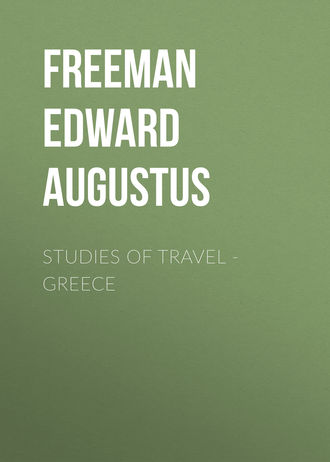
Freeman Edward Augustus
Studies of Travel - Greece
It is a wonderful thing to stand beneath these mighty walls, raised out of the huge blocks which seem too great for mortal men to have piled. Nowhere else does the line of thought which they suggest come out so strongly. On the Athenian akropolis there are blocks ruder than those of Tiryns itself, but they are hidden by the great works of more polished days. At Mykênê the walls, mighty as they are, have almost yielded to tombs, gates, and treasuries. At Tiryns it is the walls and the walls alone which seem to speak of its days of power. Tiryns struck men as being τειχιόεσσα in the days of the Homeric Catalogue. It is as τειχιόεσσα and as τειχιόεσσα only, that it strikes us still.
Argos
A short drive — we are still within the region where driving is possible — takes us from Tiryns to Argos, from the destroyed city to the destroyers. The contrast is striking. Argos, through all changes, has always remained a dwelling-place of man, and not only a dwelling-place of man, but a town of some importance, according to the standard of its own age and place. Modern Athens is an artificial city. It is a town which might have stood anywhere else, built at the foot of the ancient akropolis and around the churches of Eirênê. Modern Argos is not an artificial town; it has come to be what it is by the gradual operation of ordinary historical causes. It shows us what an ancient Greek city, neither ruined nor forsaken nor artificially fostered, but left to the working of natural circumstances, finds itself after long ages of Roman, Venetian, Turkish, and restored Greek rule. The chief remark which the place suggests to a Western eye is how little there is to remark. In the modern town there is no remarkable building of any kind, old or new. The modern cathedral is large and is meant to be of some pretensions, but one would gladly exchange it for the tiny metropolitan church of Athens, or for any other church of genuine Byzantine style and date. The town itself covers a large space, and contains a considerable population. Setting apart the capital and the great seaports, Argos ranks high among the existing cities of Greece. Yet to a Western eye it has an unpleasing, almost a barbarous, look. It is dirty, irregular, with neither Western neatness nor Eastern picturesque effect. An old Venetian possession, one might have expected that St. Mark might have planted somewhat of his impress here, as he has done on so many of his subject cities. If Argos were even as Traü, no one would complain, but, since the Venetian, Argos has seen the Turk, and that is enough to account for the difference. Argos is not lacking in recent history. It was the scene of important events during the War of Independence, when it acted several times as the common meeting-place of Greece. It is still, we believe, a thriving place after its own standard, but that is not the standard of Western Europe, nor yet the standard of Syra and Patras. Yet it sets us thinking whether a town in Western Europe, five or six hundred years back, may not have looked much the same. In one point indeed there was a difference. No Western mediæval town of the same population as modern Argos would have spread over the same space. That is to say, the modern town lies scattered, doubtless because it represents an ancient city of far greater extent.
But the objects which give Argos its main interest in the eyes of the historical inquirer, the objects which bear witness to the existence of Argos in the days of its greatness, lie outside the modern town. One, the chief of all, proclaims its presence from afar. The akropolis of Argos, the famous Larissa, the soaring height crowned by the stronghold which from a primæval fortress grew into a modern castle, is an akropolis in quite another sense than the lowlier hill of Tiryns, or even than that of Athens. The name leads to a long train of thought. It is the Larissa of Argos. How many spots bear the name of Larissa? How many lands and cities bear the name of Argos? He who has a taste for Pelasgian speculation has a wide field opened to him. He who keeps himself within the range of recorded history and of such tradition as may be said to prove itself, may perhaps be led to think how largely the fame of Argos is a borrowed fame. Argos and the Argeians meet us in every page of the Homeric tale; they seem to be the most familiar names for Greece and the Greeks before Greece and the Greeks had as yet an acknowledged common name. A little thought will, however, show that in most of the places where they are named there is no immediate reference to the local city of Argos. The Bretwalda of Hellas ruled over many islands and over all Argos. Whatever this means, it can hardly mean anything short of all Peloponnêsos; at least it cannot mean the local Argos, which did not come within his immediate kingdom. To suppose any reference to the local Argos would be like quartering a Karling at Paris or a West-Saxon at York. But the local Argos dealt with Mykênê like the savage who swallows the eye of his slain enemy in order to take to himself his strength, courage, and glory. Only a few years after Mykênê fell we find the Attic dramatists transferring the whole tale of Pelops’ line from its own place to the destroying city. The confusion has become hopeless. Argos becomes surrounded by a mythical glory to which it has no claim. The name of Argos brings up a crowd of associations, most of which it is our first duty to drive back. We must remember that Agamemnôn — we take the personal name to express the fact of the Mykênaian empire — was lord of the local Argos only in the sense in which he was lord of any other spot in Peloponnêsos. The two neighbouring cities were the heads, as the Catalogue shows us, of two kingdoms of strangely irregular shape, but whose very shape is the sign that the geography is genuine. No inventor could have hit on anything so unlike the arrangements of historic Greece. Argos destroyed Mykênê and took its glories to itself. If we can conceive Paris and Laon — or, by a still bolder flight, Paris and Aachen — within sight of one another, and if we can further conceive the elder seat of rule not only robbed of its history, but actually rased to the ground, by the younger seat, we shall get a fair illustration of what really happened in the case of Argos and Mykênê.
Yet Argos has a history of its own, and that a long and stirring history, though it is a history which can seldom be called honourable, and one which never, in the days of contemporary record, places the city in the first rank, along with Sparta, Athens, and, for a moment, Thebes. In contemporary history Argos seems chiefly to live on the memory of earlier days when she did hold such a place. And it is one of Mr. Grote’s services to those parts of Grecian history which lie rather out of the range of his main strength that he has brought out clearly that there was a time when Argos did hold the first place in Peloponnêsos. In the Iliad she is one of the three cities which Hêrê best loved, but which she could endure to see overthrown as the price of seeing the overthrow of hated Ilios. Argos there ranks with Sparta and Mykênê. When the day of overthrow came, when Achaian rule gave way to Dorian, when Argos in the wider sense became Peloponnêsos, the local Argos appears as first of three chief Dorian powers, with Sparta and, no longer Mykênê, but Messênê — the land and not the later city — as her secondary yokefellows. Prima inter pares among these, she gradually loses the first place to Sparta, and spends the rest of her days as a Greek city in feeble assertion of the place which she had lost. In every age of Greek history, in the days of Persian, Peloponnesian, Corinthian, Macedonian, and Achaian warfare, the name of Argos meets us at every page, but the annals of the city are nowhere adorned by any great strokes of heroism or wisdom. Her policy is often isolated, often cowardly, almost always dictated by jealousy of Sparta. In her last age Pyrrhos dies beneath her walls, and she joins the League under a reclaimed tyrant. But the distance between Aristomachos and Lydiadas may mark the distance between Argos and the first of Grecian cities, when that name had passed away from Argos, Sparta, Athens, and Thebes to Megalopolis, mother of Achaian statesmen.
Still with all this, Argos is a great name. A continuous being, a continuous history, from the Homeric Catalogue to the War of Independence, is something which Megalopolis and even Sparta cannot boast of. Sparta —Lakedaimonia in later phrase — gave way to Misthra; modern Sparta is a new and artificial creation. But Argos, the Argos that we now see, with its queer-looking streets and shops and open spaces, is, by unbroken succession, the city of Diomêdês, the city of Kleobis and Bitôn. We look in vain for the temple which witnessed the filial piety of Kleobis and Bitôn, but the Larissa of Diomêdês, the Aspis— the shield of Argos — which was stormed by the last Kleomenês, is there still. The huge hill with the ruined buildings at the base, with the castle containing remains of almost every age on its crest, with the signs of human occupation covering almost every step of its steep sides, all are now utterly desolate, but they bear witness to the lesson that the modern town over which they soar is the unbroken successor of the dwelling-place of man in præ-historic times. The Larissa of Argos is an akropolis indeed, utterly dwarfing, as far as the works of nature go, the far lowlier height of primæval Athens. No Parthenôn, no Propylaia, crowned the hill of Argos. The nature of the site could hardly have allowed them to stand there, and, if it could, they would have seemed out of place on that mountain-top. The fortress however is there, shattered and forsaken as it is; the walls of the mediæval castle are propped on the walls of unrecorded days with their vast Kyklopean masonry. Other parts rest on masonry of later date, but still masonry of early Hellenic times, stones which were there before Argos thought it her interest in the greatest national peril of Greece, to find out that her hero Perseus was the forefather of the invading barbarian. We look down from the height on the modern city, on the plain, on the gulf which parts the Argolic Aktê from the main mass of Peloponnêsos; we mark the coast stretching away towards the hostile Lakonian land; we gaze on the mountain heights of the central land of the peninsula, fencing in the home of that old Arkadian race which boasted that alone among Greeks it had never changed its dwelling. There rises Artemision, there rises the hoary peak of Kronion, its snow-capped crest seeming no unfit dwelling-place of the aged god who reigned before Zeus and his children. At the foot of the hill lie a number of buildings, all forsaken and shattered, witnessing to the many changes which Argos has seen, to the many masters who have ruled over her. There is one piece of mighty ancient walling strangely brought together with sculpture of Roman times. There is the theatre with its ranges of seats cut deep in the hill-side, a theatre looking out on the wide expanse of city, plain, sea, and mountains. Almost at its foot stands a ruin of the days when Argos formed part of the subject lands of the city by the Tiber, a ruin which bespeaks its kindred with the baths of Antoninus, and shows us in all its boldness the great constructive invention after which men strove at Tiryns, but which Greece, in all other things the mother of arts, had to learn from her Roman masters. We look at the broken brick vault of the Roman building, but if our eye turns a little to the right, we soon see how it was the lands east of the Hadriatic which first learned how to give the great constructive invention of Italy its noblest form and to apply it to its highest use. At no great distance from the Roman ruin stands a church of Byzantine days, which fitly finishes the series. The forms to which men were feeling their way in the sally-port of Tiryns and in the treasure-house of Mykênê reached their perfection when the architects of the East taught the cupola, soaring or spreading as it might be, to rise on its supporting columns over the centre of the churches of Eastern Christendom. Primæval Greece strove after the arch; historic Greece, if she knew its constructive use, confined it to a few purposes of constructive usefulness. Primæval Italy strove, and strove with more success, in the same path, and made the form which Greece used so timidly the life of her national architecture. On Roman ground the arch grew into the cupola, but it was on the ground that was Greek and Roman alike, on the ground of the Eastern peninsula, that the cupola took its noblest form. On the Larissa of Argos a few traces have been found of galleries like those of Tiryns. Pausanias bears witness that Argos once had her subterranean chamber like those of Mykênê, and doubtless following the same construction. At Tiryns and Mykênê the series goes no further; the destroying hand of Argos decreed that it should go no further. The long life of Argos allowed every form to stand there side by side, from the gallery and the treasury to the Roman bath and the Byzantine church. Yet it is not in Argos itself that the series can be really studied. In the life of cities nothing preserves like early overthrow, nothing destroys like continuous life. Of the members of the Argive series the latest alone is perfect. The vault of the Roman bath is broken down; the gallery can scarcely be traced; for the existence of the treasury we have only the witness of a traveller seventeen hundred years back. It is among the victims of Argos that early overthrow has preserved to us the works of the earliest times. In forsaken Tiryns and Mykênê we learn more of the earliest days of Greece than we can learn in the city which has survived them by three-and-twenty centuries. We have mused over the walls, the guarded gate, the sally-port of Tiryns; we must go on to muse on the walls, the mightier gate, the treasuries, the rifled tombs, of Mykênê, Imperial city of Hellas in her earliest day.
The Akropolis of Mykênê
Euripides was perhaps after all not so far wrong as he seemed to the mocking genius of comedy, when he raised the question whether life and death were not in truth things which had exchanged their names:
τίς οἶδεν εἰ τὸ ζῆν πέν ἐστι κατθανεῖν, τὸ κατθανεῖν δέ ζῆν;
It is at least very often so in the case of cities; it is emphatically so in the case of the great cities of the Argolic land. Argos, as we have seen, if it has not altogether died, has at least been brought down to a kind of life which, judged by its ancient standard, might pass for little better than death. Its continued being has destroyed well nigh every trace of its ancient state within the circuit which still remains inhabited. Argos is thus dead because it has lived. Mykênê, on the other hand, has remained alive because it died. Had Mykênê remained a ruling city, or even a dwelling-place of men in any shape, during all the ages which have passed since the fifth century before Christ, we should not see, as we now see, what the imperial city of the Pelopid house really was. Thanks to its happy destruction, no work of Turk, or Venetian, or Roman has ever arisen to jar on the associations of the primæval city. Even the works of those whom at Mykênê we must call the later Greeks, the men who dwelled there from the Dorian invasion to the days of Periklês, have passed away as though they had never been. No columns rise, as at Nemea, over the forsaken spot; we meet no tomb by the wayside, no legend graven on the rock, such as we light on as we tread the holy way from Athens to Eleusis. House and wall, temple and tower, were either utterly swept away by Argive wrath, or else they have crumbled away into nothingness since the scourge of Argos passed over the devoted city. Where once stood the wide streets of Mykênê, we meet only the shepherd with his crook to guide his flock, or the peasant woman, with Paionian industry, plying her distaff as she gathers her sheep or her goats to watering. For the hum of assembled citizens in the agorê, for the tramp of gathering warriors on the akropolis, we hear only the pipe of the shepherd himself and the bark of the shepherd’s dog. The shepherds who wander over the site of Mykênê may not wholly answer to the pictures of Theokritos or Virgil, but the crook, the pipe, the distaff, are here no figures of speech. They may be seen and heard daily as the sun rises over the deep gorge which fences in the Mykênaian akropolis, or when he “reigns” at eve over the heights of Artemis and Kronos. But even those few shepherds do not, like the few inhabitants of modern Corinth, dwell on the old site of Mykênê, nor do they profess to carry on the Mykênaian name. At the foot of the lower hill, the hill of the city as distinguished from the hill of the akropolis, a small church and a few houses, seeming almost to grow out of the rocky soil, form the small village, not of Mykênê but of Chorbati. Yet in one sense Chorbati has become Mykênê. Gathered there in a small museum are the less splendid and precious of the relics which modern discovery has brought to light on Mykênaian soil. And there too is one relic, torn from a rifled tomb on the akropolis, which to the eye of faith must be more precious even than the treasury and the lion-gate. There lies the nearly perfect skeleton which those who have trodden doubts and difficulties under their feet believe to be the very bones of Agamemnôn. The more cautious Greek antiquary is less rash in committing himself. Mr. Stamatâkês, the learned and zealous guardian of the Mykênaian treasury, points to it with a wise qualification. The rest of his explanation is given in the tongue which is alike his own and Homer’s. But, to express his doubts, the Hellenic lips have learned to form a Teutonic genitive. He does not commit himself to the belief that they are the bones of “Agamemnôn,” pure and simple; they are the bones of “Schliemann’s Agamemnôn.” Yet primæval Hellas, primæval Mykênê, has a history which may well live through alike unreasonable doubts and undiscerning faith. Call him what we will — Agamemnôn or anything else — the name matters little. It is a marked moment in one’s life when one looks on the bones of one who, we need not doubt, was, in days long before Hekataios wrote or even before Homer sang, a lord of many islands and of all Argos.
The position of the akropolis at Mykênê differs widely from that of either of the neighbouring akropoleis of Tiryns and Argos. The hill of Tiryns is a mere mound in the plain. The loftier hill of Argos, though far outtopped by the mountains behind it, still stands out as a marked object. But the akropolis of Mykênê, though we find it to be in a manner isolated, when we come to it, seems like an outpost of the far loftier hills immediately behind it. On one side the rock rises precipitously above a narrow gorge whose limestone cliffs at once, to an eye familiar with the West of England, suggest the gorges of Mendip, and, above all, the great pass of Cheddar. In the early days of fortifications, when there was no missile to be feared but darts and arrows, a fortress was not deemed to be in greater danger by reason of being thus overlooked. Indeed, to be overlooked by high and inaccessible mountains was in itself a kind of shelter. The Mykênaian akropolis thus stands upon the rocks and among the hills in a way in which its fellows at Tiryns and Argos do not. For that same reason it does not stand out in the same way as an object in the distant view. Its true form and position grow gradually upon us as we rise from the modern village along the paths — paths only of the shepherd and his flock — which are now all that represent the wide streets of the city beloved of Hêrê. More than one path may be chosen, and each will lead by one or more of the wonderful remains of the city itself, the so-called treasuries, as distinguished from the remains of the akropolis. But the path to be taken by choice, as it is the path to which the traveller’s instinct will most likely lead him, is that most to the right, that which skirts the brook which runs down from the limestone gorge, and which will lead his steps by the greatest monuments of all, the first and the second treasuries. But let the treasuries wait for a moment; they are works, though of unrecorded days, yet still of days far later than the defences of the akropolis itself. We will gaze first at the very centre of all, the centre, we may say, of præ-historic Hellas. And, as we draw near, we cannot help having our wrath slightly kindled against the last discoverer of Mykênê. Dr. Schliemann has done well in what he has brought to light; we cannot think that he has done well in what he has hidden. As we draw near, the height and outline of a great part of the outer wall of the akropolis are utterly hidden, the general view is spoiled, the proportion of the whole work is sadly damaged, because Dr. Schliemann chose to throw the rubbish which he dug out of the tombs anywhere where it might light. He has for the most part thrown it in vast heaps over the wall, by which a really large part of the course of the wall is hidden, and the whole view blurred and confused. A little trouble might have avoided this at first; a little more trouble might get rid of the rubbish now. In the last diggings at Athens much more care has been taken. The rubbish has been all carried away, and is piled in heaps where it does no harm. If in times to come those heaps should grow into hills like the “mons testaceus” at Rome, no harm will have been done, and an odd little piece of history will have been made. But Dr. Schliemann’s heaps of rubbish do seriously mar the general effect of the Mykênaian akropolis. They make it hard to understand the real line of the walls until we come quite close to them. Among the rocks and the walls, the walls growing out of the rocks, we see something which is neither rock nor wall, but which confuses the outline of both; as we come nearer, we find it to be the former contents of the royal tombs and of the other works which have been brought to light within the walls. As at Tiryns, there is a higher and a lower, an inner and an outer fortress within the akropolis itself. But the greater height of the Mykênaian hill makes this arrangement far more prominent, far more effective than it is at Tiryns. Only at Mykênê the lower enclosure has more of the air of an excrescence or an appendage than the lower enclosure of Tiryns. But it is this lower enclosure, the enclosure immediately entered by the famous lion-gate, which, whether an addition or not to the fortress above, has become the great centre of the associations of the place. There lie the empty tombs, thence came the wondrous treasures, which have carried us back into the depths of what we may fairly call præ-historic history, which have made us stand face to face, if not with the personal heroes of Homer, at least with the men of that age of Hellenic culture which the songs of Homer set before us.
The buildings of Mykênê have been described over and over again till their general effect must be almost as familiar to those who have not seen them as to those who have. But here, as everywhere else, it is the merely artistic character which can be thus taken at a distance. To feel Mykênê, as to feel any other place, we must see it. And even some of the artistic points can, as usual, be thoroughly made out only on the spot. One must see the place thoroughly to take in the wide difference between the masonry and artistic finish of the lion-gate and of the two chief treasuries. The lion-gate — we mean the gate itself, as distinguished from the lions — is a mere piling together of stones. The work is done doubtless with great mechanical skill, and it has the wonderful effect which all such primitive buildings have; still it is altogether without any claims on the score of art. But in the gateways of the treasuries, instead of the vast erect jambs of the lion-gate, we find well-wrought courses of stone in two orders, with something that may almost be called a moulding. These gateways had columns too. Unluckily nearly all are gone, even the precious fragment which was seen and drawn by the earlier travellers. This last, be it remembered, was of a kind which would not have looked out of place in any Romanesque building in England or Normandy. This is a most instructive fact, as the likeness must have been purely accidental; and this may serve to remind us that there are such things as accidental likenesses, and to warn us against leaping to conclusions when such likenesses are found in times and places far distant from one another. In the second treasury, the one lately brought to light by Dr. Schliemann, there is a fragment of another column, no longer in its place, which looks like the first rude attempt at the later Doric. Now over both these gateways, and also over the lion-gate, are openings of the same triangular form, though of course wrought far more carefully in the treasuries than in the lion-gate. In the treasuries these openings are openings; they are at present filled up with nothing. That over the lion-gate is filled, as all the world knows, with a basaltic stone which would seem more natural at Bamburgh than at Mykênê, carved with the famous lions, if lions they be, which guard a column that would not seem out of place in the duomo of Fiesole, in the apse of La Couture at Le Mans, or even in the slype at Worcester. Can we believe that the lion-gate and the lions, that the lion-gate and the gates of the treasuries, are all of the same date? And in point of work the lions at once connect themselves with the gateways of the treasuries, not with the gateway over which they stand. Surely we have in these gateways signs of an abiding type which lived on through several stages of advancing art. Over the square-headed gate there was to be, for whatever reason, a triangular hole, doubtless meant to be filled with a stone of its own shape. In the treasuries either this stone was never put in or it is gone. In the lion-gate it was put in, as it seems to us, when art had passed the stage represented by the lion-gate itself, and had reached the stage which is represented by the gateways of the treasuries.
Another thought suggests itself. At Mykênê, as less clearly at Tiryns, the lion-gate, with its skilfully guarded approach, does not lead at once into the higher enclosure of the akropolis, but into the outer and lower one. Does this go at all to show that this outer enclosure, at Mykênê at least, was an addition to the primitive fortress of all, fencing in the upper part of the hill? The fact that the tombs were found in the lower enclosure also looks this way. There must have been a time when this ground was looked upon as being outside the city, or it would hardly have been used for purposes of burial. The argument does not quite reach demonstration; burial within the walls was not absolutely unknown even in historical Greece, and it may not be safe to argue from historical to primæval Greece. Still the two arguments so far fall together as at least to suggest the idea that we have in the inner enclosure something yet more ancient and venerable than all — something which may have been ancient and venerable, not only in the days of Homer, but in the days of those whose tale Homer has told.
For the present we keep within the akropolis, within the old hill fort which forms the inner circle of the Ekbatana of the imperial lords of præ-historic Hellas. We stand here within the walls which struck the minds of so many of the poets of Greece in the days when their desolation was a thing of yesterday — walls which seemed too mighty to be the work of mortal men, and which, like their fellows elsewhere, were deemed to have been wrought by the same hands which forged the thunderbolts of Zeus. Here we may in truth
Φάσκειν Μυκήνας τὰς πολυχρύσους ὁρᾷν, πολύφθορόν τε δῶμα Πελοπιδῶν τόδε —
and we may deem that the house of the Pelopids was something which grew up as a new thing beneath the shadow of the Cyclopean walls. That inner fortress may well be to the Mykênaian empire of Homeric times what Roma Quadrata on the Capitol was to the Rome which bore rule over all Italy. But not a word is there in the Homeric tale to make us think that that empire was a dominion of foreign princes, or that the patriarch of the Pelopids was other than a son of the peninsula to which the race gave its name. From the akropolis one may look down on the enclosure which holds the rifled tombs, on the space beyond — the site of the wide streets of Mykênê — which holds the treasuries, and so on to destroying Argos and to Tiryns, the fellow-sufferer in overthrow. There is no other spot where we are carried so deep into unrecorded ages, and where unrecorded ages tell their tale so clearly. But the tale of the akropolis, even the tale of the inner fortress, is enough for one while. The tombs of the lower enclosure, the treasuries, if treasuries they be, of the outer city, may supply their own materials for separate thought.







